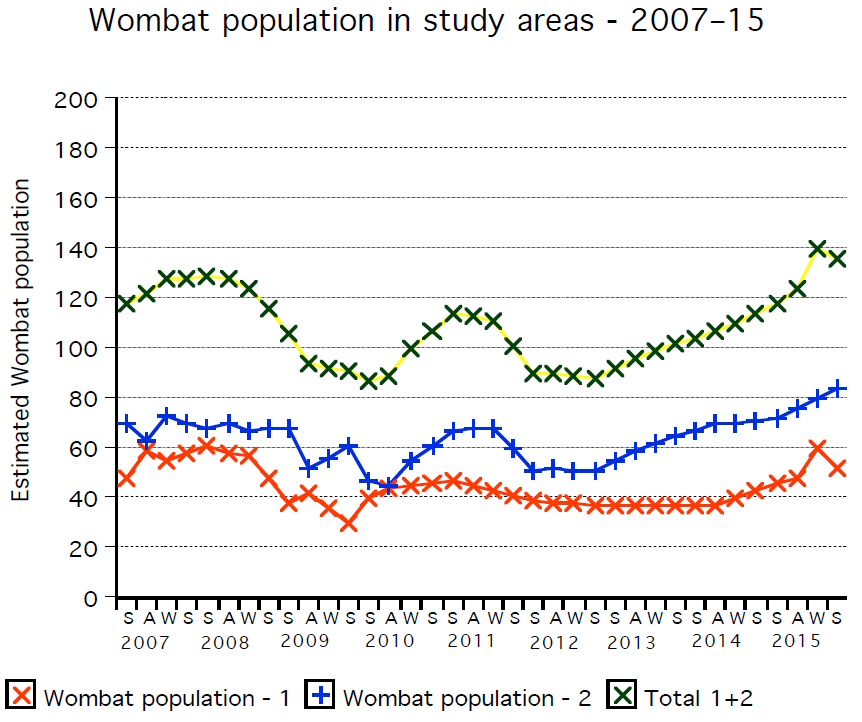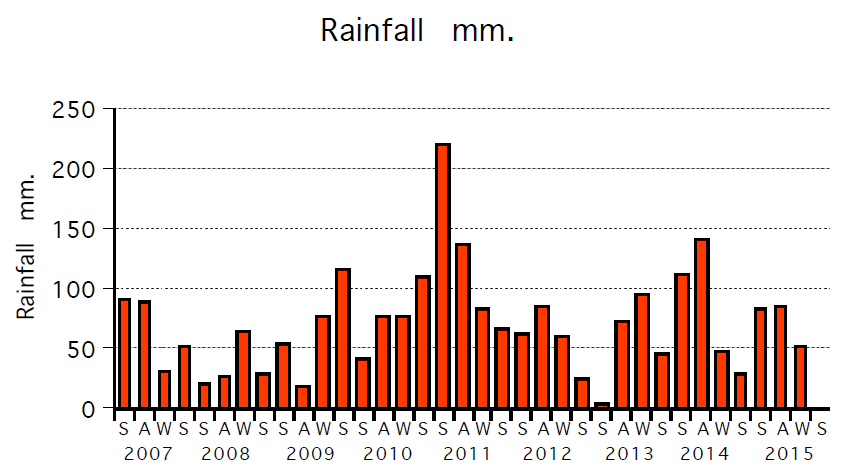Wombat Population Study in Moorunde Wildlife Reserve Study Areas
GLEN TAYLOR
The objective of the project was to estimate the wombat population and to monitor trends over an extended time as an indicator of the population status as the reserve recovered from the severe drought of 1967/68 when the plight of starving wombats had prompted the establishment of the reserve. The project, now in its 44th year, continues to provide data on wombat population trends.
Being nocturnal, wombats are difficult to count by direct observation and this study attempts to estimate the population by noting fresh signs of activity at warren entrances – scratchings, footprints and fresh droppings – that indicate an entrance is active, then relating the number of active entrances to the number of wombats.
The following procedure was adopted. After the whole reserve (5000 acres at the time) had been inspected and wombat warrens mapped, one Study Area, one specific warren and later a second Study Area were chosen for more intensive monitoring:
Study Area 1 – 1600 X 800 metres located in Moorunde (Southern section) between grids 57720E and 58520E (WGS 84) was selected in 1971. It contained Mallee scrub, shrub (Geijera) and grassland in similar proportions to the reserve as a whole and within it there are 43 warrens.
Warren No. 90 – In 1973, a recording instrument designed and built in the home workshop by the author was electrically connected to switching devices set up in each of the fifteen entrances in this warren (59225E 84575N) to record the time wombats emerged and returned and which entrances were used. It operated continuously, powered by a solar charged battery, for twenty-five years (albeit with occasional lapses when wombats dug up and chewed through wiring). By then it was considered that enough data had been collected and the recorder was shut down.
Study Area 2 – In December 1973, it was decided that another area 1600 X 400 metres between grids 60150E and 60550E could be incorporated into the study. It is mostly shrub grassland and contains 52 warrens.
Warren No. 90 was the key to determining firstly, how the visually observed signs of wombat activity at any entrance related to the actual usage and enabled the observer’s skills to be regularly calibrated and enhanced. It was found that burrows used within the previous 4 nights were interpreted by visual observations as being active with acceptable consistency, so such burrows were designated as B4. Secondly, analysis of the recorded exits and entries enabled the determination of the minimum number of wombats that satisfy the sequence of these recorded events. This was designated P and, as it represents the minimum population, is probably on the conservative side. From these a ratio of observed active burrows to population (B4/P) is determined and over a number of years a mean B4/P ratio has been established for each month of the year. These are used to estimate the population in the two Study Areas and is also applicable to the entire reserve.
Incidental to the prime purpose of the recording instrument, the records of the comings and goings of the wombats revealed interesting insights into their way of life. For instance, during winter some wombats will emerge at dusk, others a little later with activity peaking before midnight then tapering off until nearly daybreak; in summer they emerge much later after dark with peak activity after midnight and returning to their burrows well before daylight. These strategies exploit the advantages of favourable temperature and humidity. The data indicate too that the wombats’ response to drought is to dramatically reduce activity and to emerge more frequently during daylight. Reduced activity conserves energy and basking in the sun provides warmth that would normally be provided by food intake. This is consistent with studies on Brookfield by R. T. Wells.
The two Study Areas are inspected several times each year on foot to record wombat activity and to check for weeds and evidence of rabbits. Each area takes about three hours. On return home the observations are analysed, estimates of population prepared and results plotted on graphs.
The following graphs show the estimated wombat populations for Study Areas 1 and 2, the total (1+2) and rainfall plotted for the four seasons summer, autumn, winter and spring of each year 2007 – 2015.


Though the study attempts to estimate population, it is by no means a census and cannot be taken as absolute, however, the methods have been applied consistently and therefore the results are considered valid in demonstrating trends in the population over time.
This ongoing project is funded entirely by the author. The valuable assistance rendered by my son Gary during the surveying of the general reserve and each individual warren in the Study Areas is gratefully acknowledged.
Please click this link if you would like to download a PDF of this article: Wombat Population Study 2007-15
[Article as published in the September – October 2015 issue of NATURAL HISTORY: The Official Journal of the Natural History Society of South Australia Incorporated]
